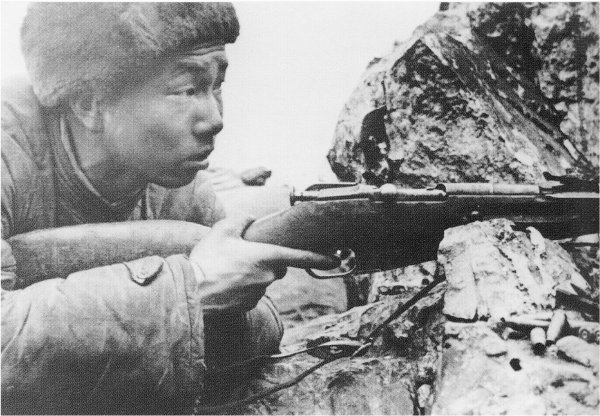This is one of the sniper rifles used by the North Koreans from the beginning, and Chinese Communists about a year later, during the Korean War.
An adaptation of the basic Soviet infantry rifle, a turned-down bolt handle was used to clear the sight.Communist snipers were trained by Soviet advisors, who were reputed to try their hand at killingAmerican troops whenever the opportunity offered.
The rifle M1891/30 is about the same length as the M1891 Dragoon, but with many improvements. Used in large numbers by the Soviets early in WWII, it was replaced by the carbine M1944 as the standard Soviet infantry shoulder weapon at the end of WWII. The rifle was very accurate, and evidently a scope was not always essential for a sniper to fire effectively.
The sniper rifle M1891/30 is basically the M1891/30 adapted for use with a telescope. The telescopes were somewhat similar to those used on US hunting rifles. Both the rifle and the sniper rifle were standard issue in some Soviet satellite armies into the 1970s.
I've mislaid the source for the following interesting commentary. (If the originator sees this,please let me know and I'll correctly cite you. The article has been confirmed by "Jarmo Mikkonen"; jj.mikkonen@kolumbus.fi ):
"During the Winter War of '39-'40 the Russians learned from the Finnsthrough bitter experience the value of snipers. Simo Hayha, a farmer, iscredited with the killing of over 500 Russian soldiers in fifteen weekswith his Model 1928 Mosin-Nagant rifle. As a result, the Russians beganto place more emphasis on their sniper training programme.
Production of the 1891/30 sniper rifles began in 1937 and ended in1963 when the 1891/30 sniper rifle was replaced by the Dragunov sniperrifle. Sniper rifles were chosen for accuracy from the production lines,had the bolt turned down, and were fitted with a telescopic sights. Apartfrom these differences, they were the standard 1891/30 rifle. Two typesof scope were used, the earlier 4 power P.E. scope and the compact 3.5power P.U. scope. The best of the Russian snipers preferred the 1891/30 to the SVT40,which was also issued in a snipers model, because they were more reliableand the action made practically no noise."
Extract from: "Enemy at the Gates - The Battle for Stalingrad." by WilliamCraig:
"The Russians backed out of their trench. Anxious to put theGerman sniper in a maximum amount of blinding sunlight, they followed theirregularly curving front line until they found a spot where theafternoon sun would be at their backs... Aware that the sun would reflecton their scopes, they waited patiently for it to go down behind them. Bylate afternoon, now wrapped in shade, they had Konings at a disadvantage.Zaitsev focused his telescopic sight on the Germans hiding place. Apiece of glass suddenly glinted at the edge of the sheet. Zaitsev motionedKulikov, who slowly raised his helmet over the top of the parapet.Konings fired once and Kulikov rose, screaming convincingly. Sensingtriumph, the German lifted his head slightly to see his victim. VassiliZaitsev shot him between the eyes...
Zaitsev is credited with 242 kills in Stalingrad before he wasinjured by a landmine."


